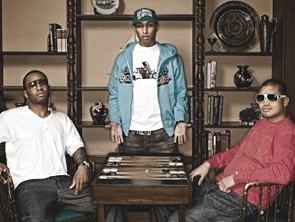N.E.R.D. producers discuss production techniques and drum programming on the new album, Seeing Sounds. Via Remixmag
“Every studio we go to Pharrell asks, ‘Do you have my buckets set up?’” Coleman says with a laugh. “He uses anything: a paint can, a big 50-gallon drum, trash buckets. Pharrell typically plays 20 buckets at once. He’ll use one like a deep trash bucket for the kick sound, then one with a sharper attack for a snare sound, metal buckets for a percussive feel. He will go from bucket to bucket. It’s not like he’s playing all the buckets as a kit. He will program a kick and a snare, then we will go behind that and use different bucket sounds to add to the programmed sounds. We put buckets on everything, even recent tracks with Missy Elliott. Sometimes we just empty the garbage from the bathroom trash cans and use those in the studio. It’s almost a secret, but it’s just buckets, man. It’s really hype, and it’s really raw. It is what gives their music that crazy raw feel and a lot of attack.
“Pharrell will also do a couple tracks just improvising,” Coleman continues. “Then we will pick the best eight-bar loop from what he did. I use the vocal mics on the buckets, usually a Sony C800G into the Avalon 737. We will even grab one kick-drum bucket or snare and replace it with a programmed kick to make sure it is tight. I might align the buckets with the tom fills sometimes using Pro Tools’ SoundReplacer plug-in. You can analyze a tom track and set a threshold of sensitivity and actually set a trigger point so when Pro Tools sees that attack, it will use whatever sample or bucket sound you want and play it at the same exact time. You can have a tom hit; then the bucket hit is triggered by SoundReplacer. So if you have a kick drum you are not happy with, you can use SoundReplacer and demo any kind of kick that you want.”
Williams’ buckets matched with Fawcett’s live drums are the meat of N.E.R.D’s rocket projectile sound. Seeing Sounds leaps out of the speakers, its collective energy and exceptionally clean presentation the exact opposite of many commercial releases. But the N.E.R.D camp took as much care in recording the live drums as with Williams’ banging buckets.
“Eric plays drums on all tracks,” Coleman says. “Usually I put a Sony C800G waist high pointed at the kick drum but a little higher, aimed at the middle of kit. I call it a front mic. I’ve always done that; I did it on the Justin Timberlake record. It’s like you’re standing in front of the drummer as he is playing. It captures that vibe like you are sticking your head right in the middle of the set. I also close-miked the snare with a Shure SM57 and put an AKG D 112 into the hole in the bass-drum head. For mic pres, I use a Neve 1073 or 1081 on the kick and snare, an Avalon 737 for the front mic, a Purple Audio Biz for the Neumann 47 fet on the second kick-drum mic (room mic) and a Shadow Hills Gamma for the 57 on the snare. Finally, I use a John Hardy M-1 Dual Preamp for the overhead Neumann KM 84.”




